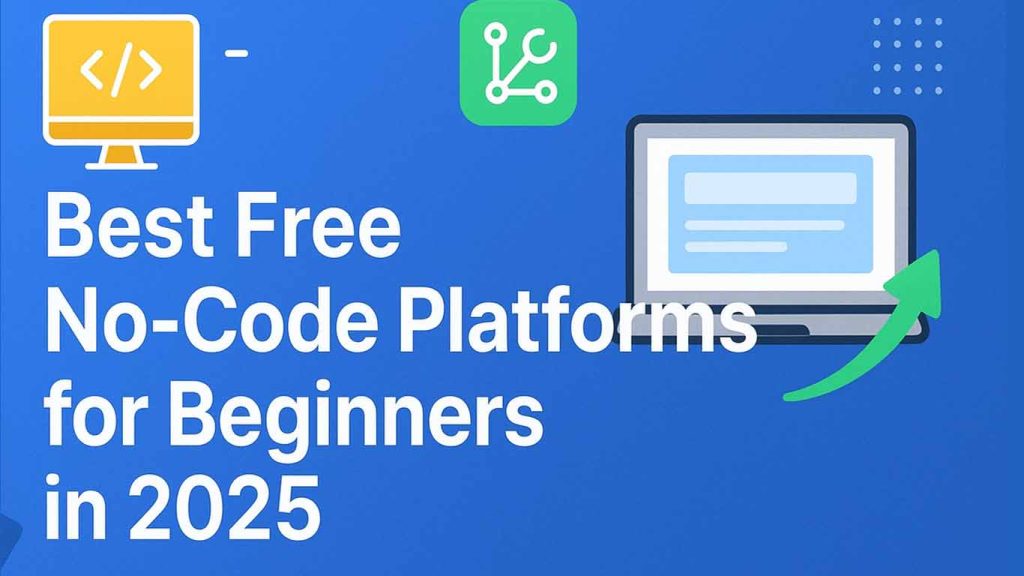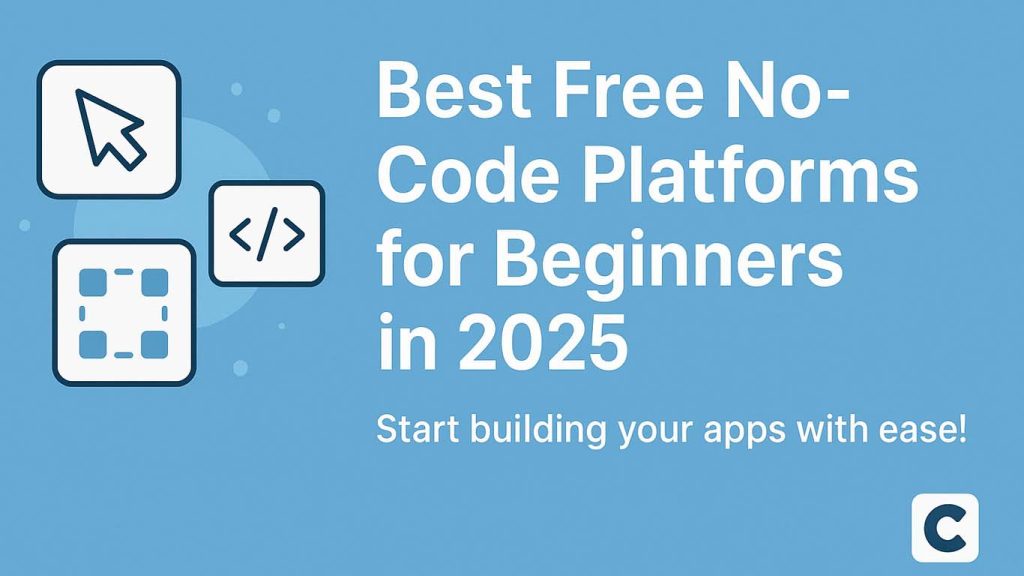
Best Free No-Code Platforms for Beginners in 2025
Introduction: The Rise of No-Code Platforms
The digital landscape has dramatically transformed, enabling anyone with an idea—regardless of coding expertise—to build functional digital solutions. No-code platforms have emerged as the catalysts behind this democratization, empowering beginners to develop websites, apps, and automated workflows through intuitive visual tools.
By 2025, these platforms have not only gained popularity—they’ve become indispensable, especially for beginners, freelancers, students, and entrepreneurs looking to prototype or launch projects quickly and affordably. With AI-powered features and sophisticated design interfaces, no-code platforms are making the leap from experimental tools to mainstream development solutions.
Selection Criteria for the Best Free No-Code Platforms
To identify the standout platforms in 2025, we evaluated:
- User-Friendliness: How accessible is the interface for beginners?
- Functionality: What can the free plan actually deliver?
- Community & Support: Are there learning resources and active communities?
- Scalability: Can users grow their projects beyond the basics?
- Learning Resources: Are tutorials, templates, and documentation available?
We cross-referenced expert reviews and recent rankings to ensure our list is both authoritative and up-to-date.
1. Bubble
Overview & Credibility: Ranked among the top no-code platforms app builders by Zapier based on extensive real-world testing Zapier and included in TechRadar’s 2025 top picks TechRadar.
Key Features
- Visual programming with drag-and-drop UI, workflows, and database control
- Plugin ecosystem and API integrations
Ease of Use - Moderate learning curve; excellent resources like Bubble University assist beginners
Community & Support - Highly active forums and template-sharing ecosystem
Use Cases - Ideal for web apps, marketplaces, SaaS platforms
Pros & Cons - Pros: Highly customizable, robust free tier, scalable
- Cons: Requires time investment to learn; performance limitations on free tier
2. Adalo
Overview & Credibility: Touted by Adalo’s own blog as offering unmatched balance of design and functionality for non-tech users adalo.com. TechRadar also cites Adalo as the best mobile app creator in 2025 TechRadar.
Key Features
- Drag-and-drop builder for native mobile apps and PWAs
- Database integration and Stripe-based payments
- Generous free plan supporting multiple projects
Ease of Use - Very intuitive; designed for solopreneurs and beginners
Community & Support - Templates, tutorials, and active user base
Use Cases - Prototyping MVPs, mobile apps, responsive web apps
Pros & Cons - Pros: Great free tier, easy publishing, modern design
- Cons: Limited performance and branding on free version

3. Glide
Overview & Credibility: Recognized in multiple expert lists—including Zapier (2024) Zapier and Dreamgrow’s 2025 roundup Dreamgrow—for its simplicity and mobile focus.
Key Features
- Converts spreadsheets into mobile/web apps via Google Sheets
- Offers templates and clean UI components
Ease of Use - Extremely beginner-friendly; ideal if you’re already comfortable with spreadsheets
Community & Support - Active forums, Glide University resources
Use Cases - Small directories, event apps, data-driven mobile interfaces
Pros & Cons - Pros: Fast setup, intuitive, generous free plan
- Cons: Limited customization, advanced features behind paywalls
4. Webflow
Overview & Credibility: Featured by TechRadar for its seamless HTML/CSS export and design-oriented workflow TechRadar; recognized by Knack in its 2025 guide as a powerful no-code platforms design platform knack.com.
Key Features
- Pixel-perfect visual editor with CMS, hosting, and responsive design
Ease of Use - More complex for absolute beginners; Webflow University offers structured learning
Community & Support - Extensive template marketplace and design forums
Use Cases - Business sites, professional portfolios, design-driven applications
Pros & Cons - Pros: Professional polish, CMS power, high flexibility
- Cons: Subdomain on free plan, design complexity for newcomers
5. Airtable
Overview & Credibility: Mentioned in Treehouse’s 2025 guide as a top choice for managing data-heavy projects Treehouse Blog.
Key Features
- Spreadsheet-database hybrid with templates and automation options
- Integrates with tools like Zapier
Ease of Use - Simple to get started—Excel-like but visually powerful
Community & Support - Forums, rich tutorial library, strong Slack community
Use Cases - Project management, content planning, CRM, lightweight apps
Pros & Cons - Pros: Very accessible, strong est free tier, good integrations
- Cons: Automation and advanced features limited on free plan; not ideal for full apps
6. Zapier
Overview & Credibility: Featured among Treehouse’s top 12 no-code platforms tools of 2025 Treehouse Blog and widely known as the automation leader.
Key Features
- Automation between 6,000+ apps via visual workflow builder (“Zaps”)
Ease of Use - Highly intuitive; easy to set up basic automations
Community & Support - Extensive knowledge base and forums
Use Cases - Workflow automation, task integration, small business processes
Pros & Cons - Pros: Easy, effective, broad integrations
- Cons: Free tier is limited in task count, advanced workflows require paid plans
7. **Bubble, Adalo, Glide—and More: Broader Landscape
Other platforms deserve mention for their unique strengths:
- Softr, Voiceflow, Bravo Studio, Xano: Featured in Treehouse’s 2025 roundup as top no-code platforms/AI app builders for diverse purposes Treehouse Blog.
- Blaze.tech: Prioritizes compliance (SOC 2, HIPAA) for regulated industries like healthcare or finance blaze.tech.
- Base44: An emerging platform that generates full-stack apps through chat-based prompts—ideal for rapid prototyping using conversational AI. Core features are free Wikipedia.
- Baserow: An open-source, self-hosted alternative to Airtable, with light AI support and scalability for team projects Wikipedia.
Expert Insights & Real-World Impact
Recent trends show no-code platforms tools are reshaping startup innovation. The Economic Times reports that founders are using Bubble, Webflow, Notion, Glide, Make to go from concept to MVP in a matter of days The Economic Times. These platforms and tools are lowering barriers and enabling rapid experimentation.
Meanwhile, GitHub’s new launch—GitHub Spark—offers a full-stack app builder without code, targeting non-technical creators and underscoring the broader momentum behind no-code platforms adoption The Economic Times.
Recommendations: Matching Platforms to Your Needs
| Your Goal | Recommended Platform(s) |
|---|---|
| Build scalable web apps | Bubble |
| Create mobile apps (iOS/Android) easily | Adalo, Glide, Bravo Studio |
| Design pixel-perfect websites/CMS | Webflow |
| Manage data and workflows visually | Airtable, Baserow |
| Automate tasks across tools | Zapier |
| Ensure regulatory compliance | Blaze.tech |
| Rapid AI-powered prototyping | Base44, GitHub Spark |
Conclusion
In 2025, no-code platforms have matured from experimental tools to powerful, accessible engines of innovation. Their free tiers now offer robust capabilities, and platforms like Bubble, Adalo, Glide, Webflow, Airtable, and Zapier stand out for beginners. Yet, even newer entrants like Blaze.tech and Base44 are redefining what’s possible, blending compliance, AI, and conversation-based creation—all without writing code.
As the no-code platforms landscape continues to evolve, choosing the right tool depends on your project’s needs: scale, time, complexity, industry requirements, or focus on design. Start exploring, build prototypes, and discover how easily your ideas can take shape without a single line of code.
